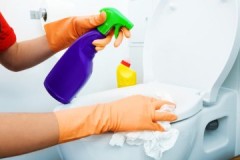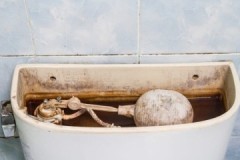Always at hand, or how to remove rust from the toilet at home with folk remedies
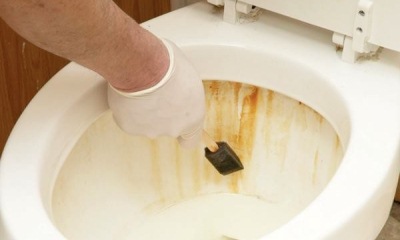 Keeping the toilet bowl clean is only possible with regular cleaning.
Keeping the toilet bowl clean is only possible with regular cleaning.
To prevent rusty streaks, it is possible to use not only purchased drugs, but also available home remedies.
In this article, we will tell you how to remove rust from the toilet with folk remedies at home.
Content
Where do rusty streaks come from?
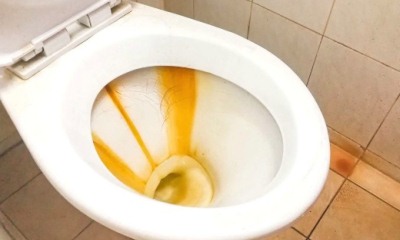 Rust marks on ceramics are the result of metal oxidation. The source may be a main pipeline that is in poor condition.
Rust marks on ceramics are the result of metal oxidation. The source may be a main pipeline that is in poor condition.
In this case, corrosive particles of non-galvanized pipes with water fall into the toilet bowl, leaving noticeable reddish traces with regular draining of water.
Water with a high iron content and rusted fasteners inside the tank also contribute to rusty streaks. In the absence of proper care, traces of rust become not only noticeable, but also difficult to remove.
The quality of the plumbing itself makes the situation worse in terms of maintaining cleanliness:
- irregularities on the ceramic surface;
- microcracks.
Damage can appear as a result of:
- non-observance of technology during manufacture;
- when exposed to contrasting temperatures during operation, as well as improper care.
How to clean the surface?
Before starting the cleaning process, it is necessary to carry out preparatory measures:
- take care of protective equipment,
- prepare brushes,
- washcloths,
- rags.
It should be borne in mind that not all home remedies are equally effective and safe.
Lemon acid
Citric acid is one of the most affordable ways to remove rust. Its downside is insufficiently high performance. If there is a lot of rust, and the traces are old, then it is better to use another recipe.
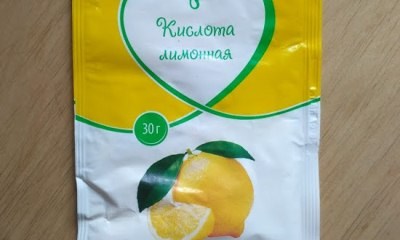 Instructions:
Instructions:
- Pour powder on a cloth moistened with water.
- Rub the rusty areas.
- Leave for 1.5-2 hours.
- Wash off with a brush.
Replacing citric acid with lemon juice is not worth it, since the effect of such a procedure will be even lower.For more information on how to use citric acid in the fight against rust, read here.
Vinegar and lemon
The result from using citric acid can be enhanced by combining it with vinegar in equal proportions.
It is not difficult to use such a composition:
- using a rag, you need to apply the prepared product to the faience;
- leave to act for a couple of hours;
- rub;
- wash off.
Learn more about using vinegar to remove rust. here.
Ammonia
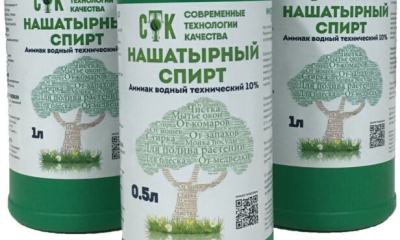 Ammonia can be used to remove rust in pure form, or diluted with hydrogen peroxide. In the latter case, 5 parts of ammonia are taken for 1 part of peroxide.
Ammonia can be used to remove rust in pure form, or diluted with hydrogen peroxide. In the latter case, 5 parts of ammonia are taken for 1 part of peroxide.
Algorithm of work:
- The active substance is applied to the drips.
- Leave for half an hour or an hour.
- Clean with a brush.
- Wash off.
Soda
Baking soda is one harmless product that you can use to clean your toilet. It disinfects and cleans due to its abrasiveness.
Soda is used by diluting with water (or hydrogen peroxide) to the state of gruel... The resulting product is recommended to be applied to the stained areas. After the composition has dried, it is washed off with water, and the stains are rubbed with a brush.
Electrolyte
Battery electrolyte is another product that works for rinsing away rusty marks.
Procedure:
- Apply the product to the area that needs cleaning.
- Wait a quarter of an hour.
- Rinse.
Working with electrolyte requires increased attention and fulfillment of all requirements of protection against a poisonous preparation.
Oxalic acid
The acid comes in powder form. In order for the drug to work, it is recommended to work according to the following algorithm:
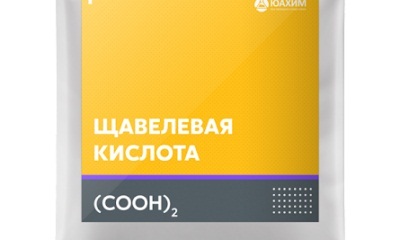 moisten rags with water;
moisten rags with water;- apply oxalic acid to the rags;
- wipe the places with streaks of rust, if possible, leave a rag on the affected area;
- stand for 10 minutes;
- wipe with a rag again;
- remove rags;
- wash off.
Toothpaste
A paste with a whitening effect is better suited to attack traces of rust. It has a mild abrasive effect on stains. It is applied with rubbing movements into the rust and left for at least half an hour. After that, the paste is washed off with water, helping yourself with a brush.
White
Chlorine bleaches not only clean, but also disinfect the toilet bowl. Work should be carried out only when good ventilation is provided (hood turned on or drafting).
Cola
Using Coca-Cola to remove rust is one of the common homemade recipes. Its efficacy is based on the inclusion of phosphoric acid in the drink.
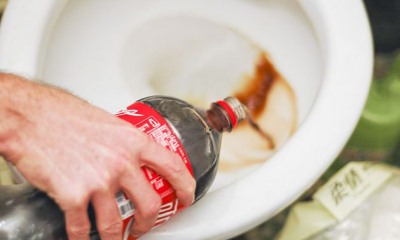 Procedure:
Procedure:
- pour at least 1 liter of drink into the toilet;
- if especially dirty areas are located under the rim, you can soak a rag with cola and place it directly over the stains;
- leave for an hour or longer;
- remove the rag;
- wash off using a brush.
It is not advisable to replace Coca-Cola with another carbonated drink, as the effect may decrease. Most sodas contain citric acid, not phosphoric acid, and, moreover, in a very low concentration. Read more about the method of cleaning rust with Coca-Cola in this article.
Advantages and disadvantages of improvised means
Folk cleansers have many benefits. These include:
- low cost;
- availability of purchase;
- simple application;
- some of them are environmentally friendly and safe (soda, citric acid, etc.).
Disadvantages of using homemade recipes:
- not always high efficiency, especially in advanced cases;
- multiple repetition of the procedure may be necessary, which makes the process more expensive;
- it is required to use personal protective equipment when using some means (electrolyte, oxalic acid, etc.).
Prevention of plaque
In order to avoid the stress of cleaning a dirty toilet with persistent rust stains, it is necessary to put into practice preventive measures.
These points include:
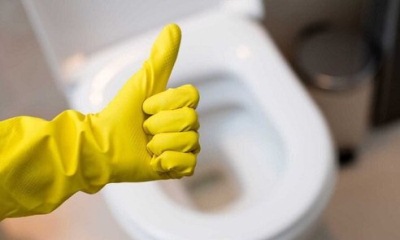 Timely elimination of water leakage from the tank.
Timely elimination of water leakage from the tank.- Installation of a purification system (filter) on the incoming water if its quality at the inlet is not satisfactory.
- Carrying out regular cleaning of the toilet. For this, chlorine bleach or a special agent can be used.
- The use of special tablets against rust and lime, which are placed in the cistern or mounted under the rim of the toilet. They have a fairly long-term effect - up to several weeks.
- The obligatory flushing of water after using the toilet will prevent the formation of limescale and urinary calculus, which complicate the maintenance of plumbing fixtures, forming stubborn dirt with the participation of rust.
10 recommendations
The following tips will help you clean the plumbing:
- All work must be carried out in protective equipment. Minimum wearing rubber gloves. This will protect your hands from drugs used during processing. It is also advisable to use a waterproof apron to protect clothing.
- Any cleaning work must be carried out with good ventilation.
- If you plan to replace the toilet, then porcelain sanitary ware has the best performance. It has a smoother and less porous surface compared to faience.
 Don't ignore preventive measures. In their absence, the appearance of plaque is a matter of time.
Don't ignore preventive measures. In their absence, the appearance of plaque is a matter of time.- For old rust stains, cleaning with any of the products the first time may not work and will have to be repeated several times.
- Do not use several products from different recipes at once. Not all of them are compatible with each other.
- For cleaning, you can use not only a brush, but also a sponge with a hard side, as well as brushes. Rags are less effective as a cleaning tool.
- You should not try to scratch off the plaque, use blows or other excessively vigorous actions, since the use of force can lead to cracks on the ceramic object.
- If water leaks from the tank, and the breakdown has not yet been eliminated, then it is advisable to shut off the water supply for the period of cleaning, and drain the one that is already in the tank. This will prevent the cleaning agents from rinsing off.
- The application of any of the products should be abundant, completely covering the areas with rusty spots.
You will find all the most important about the methods and means for cleaning the toilet bowl from rust here.
Related videos
How to remove rust from the toilet, video advice:
Conclusion
It is quite possible to remove rust from the toilet, even using folk recipes. The choice of the method should take into account the neglect of the situation, since some drugs, mild in action, are not able to eliminate serious chronic contamination.

